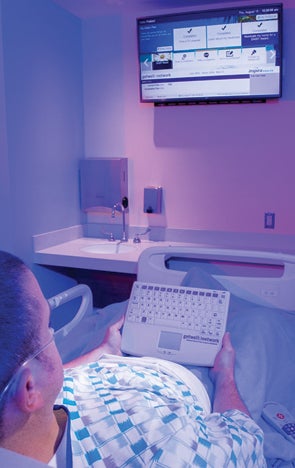Smart room tech streamlines care

A patient education and entertainment system connects patients to their care team.
Image courtesy of Inspira Health
Inspira Health’s newest hospital is all about making direct connections. From its real-time locating system (RTLS), to its virtual patient bed guardrails, the 465,000-square-foot Inspira Medical Center Mullica Hill, N.J., incorporates technology that streamlines and improves care while providing what its hospital leaders describe as a “wow” experience.
“We really want to be as paperless as possible and improve communication throughout the care team to make sure they are as efficient as possible,” says Tom Pacek, CIO and vice president of information systems.
The use of smart tech starts from the moment a patient is admitted into the all private, 210-bed hospital. When a nurse takes a patient’s vital signs, the information is immediately uploaded from the medical device and pops up on a screen for the nurse to visually confirm. With a click of a button, the patient’s record is updated in real time, and a physician will get an immediate alert if there are any concerning signs. Pacek says it’s a far cry from the days of nurses manually updating patient records.
Another high-tech feature is its virtual guardrail system. Staff at a central station continually monitor patients through video feeds. However, the additional technology acts as an observer of fall-risk patients by creating an electronic clearance area around the patient’s bed. If the system detects certain motions outside of that clearance, the staff will get an alert and have immediate voice connectivity to speak with the patient
Many of the technologies at the hospital are aimed at patient satisfaction and engagement. The nurse call system, for instance, connects to more than just the nurse. If a patient needs their wastebasket emptied, they can go directly to environmental services. If the room is too hot or cold, they can contact facilities staff.
Another process designed for patients are the RTLS badges worn by health care staff that identify who they are and their credentials directly onto a screen in the patient’s room. Digital whiteboards outside of each room replace old-school whiteboards and paper charts to display a doctor’s special orders in real time and ensure all health care staff are on the same page. “We see this as a huge patient satisfier,” Pacek says.




